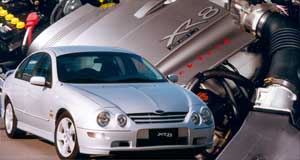Ford fights back with XR8
BY MARTON PETTENDY | 5th Jul 2001

Lifted directly from Ford's T-Series luxury sedan range, the Tickford-built Windsor V8 all but matches the peak power and torque outputs realised by the 5.7-litre Chevrolet V8 fitted to its top-selling opposite number at Holden.
This means for the first time since Holden employed V8 Chev firepower for VTII Commodores in mid-1999, Ford's highest-profile performance car should match Holden's for straight-line acceleration.
"Our performance testing method shows XR8 is now line-ball with SS Commodore," Ford business development manager special vehicle operations, Gordon Barfield, said at yesterday's launch.
Specifically, Ford claims the XR8, which received the hand-built 220kW engine as a running change from June, will now sprint to 100km/h in 6.6 seconds and to 400 metres in 14.7 seconds. That's a distint improvement on the 200kW XR, for which Ford claims 7.2 seconds to 100km/h and 15.08 across the 400 metres.
Along with the 20kW power hike, the latest XR8 model upgrade includes the addition of body coloured exterior mirrors and side skirts as standard fare, while VCT XR6 models now get XR8-style, 17-inch alloy wheels as standard fitment.
Leather seat trim, a Momo steering wheel and gear knob, a 250 watt Premium sound system, the full sports bodykit and Premium brakes remain optional extras for XR buyers, but best news is XR8's retail price remains unchanged from pre-upgrade models at $45,828 ($46,548 for automatic versions).
Ford executives admitted the improved performance and specification level - at no extra cost to customers - means XR8 profit margins are taking a dive.
But it is believed the use of less costly cast-iron cylinder heads instead of the SVO-sourced aluminium units used in previous 220kW T-Series engines made the project viable.
The cast-iron cylinder heads are machined to the same specification as their alloy predecessors to provide the same 220kW peak power output at 5250rpm and maximum torque of 435Nm at 4000rpm - up from 420Nm. The iron units weigh as much as 20kg more, but they are also said to deliver lower noise levels.
Unlike 175, 185 and 200kW versions of the faithful Windsor V8, 220kW Synergy engines for T-Series and XR8 sedans are stripped to the block and rebuilt by Tickford engineers, an exercise Ford says would cost thousands of dollars in the aftermarket.
The heads are ported for better breathing and to accommodate larger (49mm inlet/39mm exhaust) valves, fitted with low-friction roller rockers and then skimmed to return to the 9.4:1 compression ratio. The rebuilding process also involves the fitting of a higher lift camshaft, modified upper and lower intake manifolds, a larger 70mm throttle body and recalibrated fuel regulator.
Each 220kW engine is engraved with its builder's signature and hot tested before being shipped back to Ford for installation. Finally, a higher-flow exhaust manifold is fitted once the car returns to Tickford.
Each engine currently requires around eight man-hours to produce, with some 20 engines built by Tickford per day. Ford currently holds an order bank of around 125 XR8s for the next month alone.
DRIVE IMPRESSIONS:
THE minute one fires up the XR8 220, it is apparent this is no garden variety XR.While the raucous, lumpy idle seems to have been tamed somewhat - thanks in part to better engine calibration and the iron heads - there is no escaping the fact that under the XR8's bonnet lurks one of the most powerful production engines ever from Ford.
Yes, the 220kW XR8 is a classic case of competition improving the breed. The Blue Oval's newest performance flagship approaches the straight-line performance levels of Ford's legendary V8 sports sedans during the power wars of the 1970s but, more importantly, should match its opposite number at Holden, the SS Commodore, for acceleration.
Independent testing has yet to verify just how fast the 2001 XR8 is, but should it fall short of Holden's flagship sports sedan, it will not be by much. Moreover, its combination of a lower first gear ratio and more effective independent rear suspension means realising the XR8's potential will be a far easier, more consistent and more mechanically sympathetic affair.
Plenty of grip, realistic gearing and bags of low-end torque not only make for quick, easily repeatable acceleration times, but the 220 XR8's real forte is in-gear flexibility.
Mash the throttle and even from idle the Ford will respond crisply, surging forward as it rides a wave of torque that extends far beyond previous 185 and 200kW iterations of the XR8.
In fact, while its predecessor ran out of puff and became coarse around 5000rpm, the 220kW version remains composed and effective all the way to redline. The extra urge is noticeable throughout the rev range and adds welcome spice to a well balanced chassis that delivers unrivalled driving dynamics.